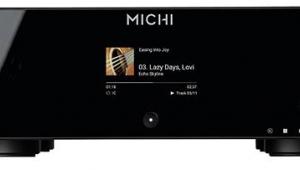Dcs Puccini (£9500)
It’s no exaggeration to say that dCS spearheaded – if somewhat reluctantly – the current vogue for upsampling to step-up the sound quality of the humble compact disc. Reluctantly because, as a company founded by earnest IC design engineers, the maths alone couldn’t readily predict any advantage in repackaging the disc’s audio data before conversion into analogue. But improvements were there to be heard, and now many high-end CD players feature upsampling. This may be as much to take advantage of modern DAC silicon which is optimised to work with ‘DVD era’ PCM digital, centred on a 48kHz baseline sample frequency.
But dCS Limited was also at the forefront of DSD technology even before SACD appeared in the late 1990s, and it wasn’t long before DSD upsampling appeared as an alternative option within its line-up of converters. Instead of reprocessing CD’s 16-bit/44.1kHz datastream into 24/96 or 24/192 PCM form, it could now be upsampled to a 1-bit/2.8224MHz format, and treated like raw DSD from an SACD disc. Not only did the standalone dCS Purcell unit get DSD upsampling added as an option, but so did the original Verdi disc transport, renamed as first Verdi La Scala, then Verdi Encore. Until this review, I’d never tried DSD upsampling, as I’ve remained deliriously happy with 24/192 upsampling from the Purcell over a ‘dual AES’ connection.
SET THE CONTROLS
So this is how the new dCS Puccini is setup when it leaves the factory, with DSD upsampling for CD engaged, although it can be easily switched off through the Puccini’s menu-driven fascia interface. Also here are options to reverse polarity (phase), switch analogue output from a nominal 2V to 6V level, and change filter (for DSD only, with Filters 1 to 4 increasing the amount of low-pass filtration of SACD’s ultrasonic hash).
Two other features present are not necessarily found on your average CD player: volume control, allowing the Puccini to be directly connect to a power amplifier; and two digital inputs, allowing other digital sources to benefit from the Puccini’s Ring DAC. However, do be aware that, unlike dCS’ previous one-box CD player, the P8i, the Puccini will not DSD upsample from these external sources.
RANDOM PRECISION
While the Puccini was settling in, I used it in regular CD mode, where it made a strong case as the fastest, most nimble and precise-sounding CD player you’re likely to hear. Randomly chosen music tracks were played with incredible transient timing, so that drum strikes and acoustic guitar strums simply zipped into the room – not as ordnance to be avoided but tangible musical events to be counted in the sum total of the performance. It was lean and pithy in the bass, yet from Kayah & Bregovic could be heard huge swathes of verdurous low-frequency drum and keyboard bass, combined to give an unassailable foundation for Kayah’s voice and the sparse acoustic instrumental accompaniment. The abiding impression of this brilliantly lit playback was a sound with immediacy and presence, taking no prisoners in showing the limit of unprocessed CD audio.
Without the benefit of any upsampling, the soundstage was gathered more within the speaker boundaries, a little ‘ceilinged’ overall, but filled with enough colour and genuine musical excitement that spatial limits wouldn’t detract from hearing into the heart of the sound.
A little more than simply suitably impressed with the Puccini’s take on straight CD, I found myself reaching toward the SACD shelf to hear how it handled DSD-mastered material. At once the Puccini threw open the proverbial window, with a fresh and boundless soundstage, such that the classic ‘Take Five’ from the Dave Brubeck Quartet sounded like premier-class LP playback, only with a noise floor merely graced with the faintest white hiss of the original magnetic tape. Incidental noises from the drum kit were now dotted around the recording like crime scene clues, as were reed noises from the saxophone, yet this was no mere performance for the musical trainspotter – as the album flowed into ‘Three To Get Ready’ it was plain to hear the interplay between musicians, oft-passed over rhythmic nuances and the practiced switches between time signatures.
A breathtaking rendition of Scheherezada [UMG] with Gergiev and the Kirov Orchestra was painted on a grand scale, powerful and resonant, and inclusive of the sweetest solo violin tone in the piece’s lyrical passages.
LET THERE BE MORE LIGHT
So with standard CD and stereo SACD playback able to draw the listener in, albeit in different ways, what of DSD-upsampled CD? I held back from this option initially, fearing it would be the worst of both PCM and DSD worlds. But by the end of the day I could appreciate why dCS has stood by the 1-bit system, out-of-band flaws and all. If undiluted PCM CD playback on the Puccini is crystalline and lightning fast, clean but uncompromising, the DSD-upsampled version is open, flowing, and – dare I say it – analogue in feeling. It takes away what you might call the ‘16-bit ceiling’ to give a thoroughly non-digital delivery, a little rosy and cloudy in places, but entirely free of mechanical stricture. Some razor speed is traded for a slower and more measured sound, relaxing and inviting, with acoustic grand piano especially benefitting from this organic effect as complex notes fade into nothing.
VERDICT
Three ways to enjoy this most accomplished of disc players: be spellbound by SACD, if your taste in music is reflected by album availability; use CD mode for crisp and explicit insight into the recording; or upsampled DSD for a thoroughly natural, flowing sound on CD reminiscent of filterless DACs, only forsaking the audible coloration and fussiness about content. In all, a treat for music lovers.
Originally published in the May 2008 issue
























































